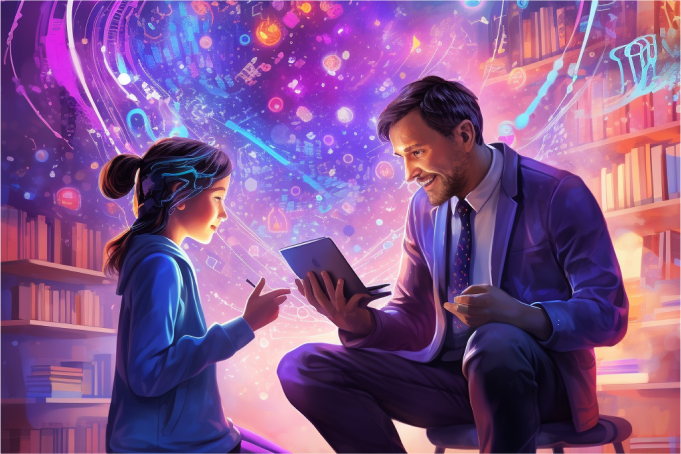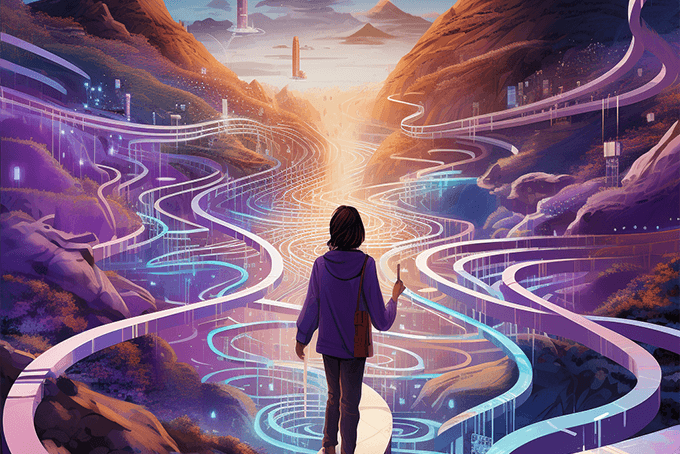Since the dawn of the modern public education system in the early 20th century, numerous innovations were supposed to revolutionize the classroom experience. The chalkboard and overhead projectors changed how teachers presented information. Buses and improved transportation to get students to school more reliably. Films, educational television, VCRs, and eventually computers brought new ways to engage with material. Yet the basic structure of education remained remarkably stagnant. Walk into most K-12 classrooms today, switch off the lights, and it would look remarkably similar to a classroom from 100 years ago – students sitting in rows, facing the teacher lecturing at the front of the room. Beyond surface-level tools, the core model of teaching and learning has not fundamentally transformed. AI Will revolutionize education in a way no prior innovation has.
Here are 3 key reasons AI will revolutionize education:
1. Personalized Learning at Scale
A persistent challenge in education is meeting the diverse needs of 30 students in a classroom. Students have different skill levels, paces of learning, interests, and optimal methods. A one-size-fits-all lecture inevitably leaves some students behind and bores others.
AI-powered tutoring systems adapt to each student’s strengths, weaknesses, and learning style. Imagine a virtual math tutor that assigns different problems, gives hints, and explains concepts in just the right way for each individual student to excel. Such personalization was never before possible in mass education.
Knewton, an education technology company, piloted an AI tutor that increased pass rates in remedial math from 64% to 76% in just 3 months. Carnegie Learning’s Cognitive Tutor improved algebra scores by 15% in randomized controlled trials. As the algorithms grow more sophisticated, expect personalized AI tutoring to become widespread and transformative.
2. Continuous Assessment
Standardized testing provides only sporadic snapshots of student progress. AI enables truly continuous assessment by analyzing students’ responses and behaviors in real-time. Intelligent software can catch exactly where a student is stumbling to inform immediate interventions.
For example, sixth grade math teacher Ms. Wilson used an AI assessment tool called Gradescope in her class. She was amazed to discover through its generated reports that half her students were struggling with fractions – a concept she thought they had mastered. She was able to quickly adjust her teaching plan before they fell irrevocably behind.
Continuous assessment creates tight feedback loops that enhance both teaching and learning. Teachers gain unprecedented visibility into student progress to personalize their instruction. Students receive constant opportunities to practice skills and receive high-quality feedback.
3. Expanding Access and Equity
Online education has long held promise for reaching students without access to high-quality schools. But scaling online teaching is expensive and labor-intensive. AI-powered software makes it economical.
An AI tutor or digital curriculum, once created, can be deployed across the globe through cloud infrastructure. Language translation abilities also allow courseware to reach students in their native language. This presents an immense opportunity to democratize access to top-tier educational resources.
For example, Byju’s, an education technology company, provides personalized math and science lessons on smartphones to over 50 million students in India. Tools like this have potential to lift up students in any remote village or underserved urban area. Top education can become universally accessible.
The Grassroots Potential of AI
Unlike prior innovations, AI in education won’t require top-down implementation. Individual teachers can immediately adopt tools like AI tutors and assessment software in their classrooms.
Kelly Simon, a 7th grade English teacher in suburban Michigan, used an AI writing assistant called Grammarly in her class this past year. “It made a huge difference in catching plagiarism and grammar errors,” she said. “I didn’t have to wait for the school to buy it – I could try it right away.”
This grassroots adoptability means AI will spread from innovative early adopter teachers to classrooms across the world. As success stories spread, so will buzz and demand for AI tools. This bottom-up change may happen faster than bureaucratic institutions expect.
Of course, institutional support and training will maximize effectiveness once adoption reaches scale. But AI doesn’t require new infrastructure or equipment installations. As long as a student has internet access, an AI tutor can be made available. This flexibility means AI will spread quickly.
The Human Touch Remains Essential
It’s important to note that technology will enhance, not replace, teachers. AI excels at personalization, continuous assessment, and scale – but cannot replicate the emotional, creative, and social aspects of human teaching. Students still need empathetic mentors.
The most powerful education will combine AI software with human teachers. Teachers freed from administrative tasks can focus on building personal connections, designing projects, and leading rich discussions. This human/AI collaboration will be the best of both worlds.
Jose Fernandez, a high school principal in New York City, foresees this hybrid model as the future: “The AI will handle quantitative monitoring and repetitive tasks, while our teachers handle the nuanced interpersonal stuff. Together they’ll achieve more than either could alone.”
The Future is Now
AI has already begun transforming some classrooms, but no one has seen its full potential yet. As algorithms evolve, best practices emerge, and teachers integrate the tools into their craft, AI will become an integral part of education. After over a century with a largely static model, education is poised for disruption.
Teachers have an opportunity to shape this transformation. By piloting AI technologies, providing feedback to creators, and finding the right balance with human instruction – teachers can guide the development of AI. The future of education will be driven by teachers who embrace this change and recognize AI’s possibilities.
The deadline for meaningful change is now. Students already live in an AI-driven world. Education can empower them to navigate it wisely – or risk leaving them unprepared. AI is the most promising opportunity in generations to create an education system fit for the 21st century. Teachers owe it to their students to lead the way as AI will revolutionize education.



